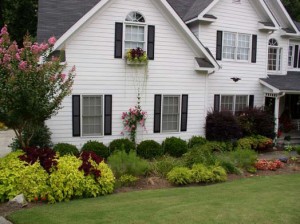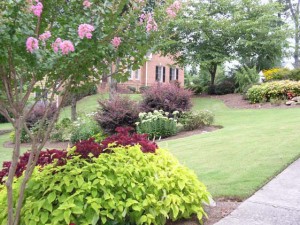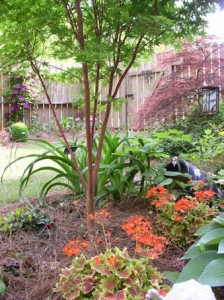 Is your week hectic like mine? Running from one task to another? Juggling family, career, household, volunteer activities, and more…leaving no time for the landscape? After the day is done and you drive into your neighborhood and approach your driveway, are you squinting your eyes filtering out what uglies lurk in your landscape? As you enter your home, throw your keys and mail on the counter, do you shut the blinds to hide what you don’t want to see outside? If you answered, “yes” to any of these questions, you have LAS, Landscape Avoidance Syndrome…………..O.K., I just made that up but many of us suffer from it!
Is your week hectic like mine? Running from one task to another? Juggling family, career, household, volunteer activities, and more…leaving no time for the landscape? After the day is done and you drive into your neighborhood and approach your driveway, are you squinting your eyes filtering out what uglies lurk in your landscape? As you enter your home, throw your keys and mail on the counter, do you shut the blinds to hide what you don’t want to see outside? If you answered, “yes” to any of these questions, you have LAS, Landscape Avoidance Syndrome…………..O.K., I just made that up but many of us suffer from it!
How about making a spring and summer resolution? Thou shalt make thy dwelling beautiful! Perhaps, like many, you’re inexperienced at this, have no idea where to start, and you’re overwhelmed. Hopefully, the following tips will take the fear out of gardening and get you on the right track to creating the beautiful curb appeal you so desire.
QUICK TIPS
Keep a clean edge
Trench around existing pine islands 3” deep and wide. This will help to keep the grass/groundcovers out as well as have a neat appearance. This works much better around pine islands in the lawn than using borders such as pavers or rock. It is much easier to maintain and mow along the edge.
In areas where shade has increased over the years and your lawn is declining, it will be best to expand the bed line and eliminate the declining lawn. When laying out new bed lines, use a hose to create gentle curves. Try to stick to an ‘S’ curve and keep it to two waves. Once you’re satisfied with the shape spray it out with spray paint. Landscape spray paint is available at most hardware stores. If this new bed encompasses lawn, either dig the existing lawn out (I prefer this) or spray with glyphosate (Roundup) prior to planting.
Spruce up the mulch
Keep a good layer of 3” deep mulch on your beds all year. This will help to discourage seed germination, keep roots moist, will break down and amend the soil, and keep soil born diseases from plants. Add your mulch in the winter after leaves have fallen and in mid summer when it starts looking faded. Avoid using gravel as a ground cover in beds. Gravel will act as a heat sink and does not amend the soil. It’s also very difficult to re-work the soil or add additional plants to soil that have a layer of gravel on it. If you have a slope, use shredded pine park mulch; it will adhere to the slope better than pine straw.
Maintenance
Pruning can be very time consuming so avoid plants that need lots of pruning; this also falls into the category of choosing the right size shrub/tree for the space. Prune leggy or sparse looking shrubs and remove any dead or diseased branches. More mature shrubs often look better “limbed up” and turned into a topiary tree-like shape. Winter is usually the best time to prune trees and shrubs. If pruning in the summer, don’t remove more than 25% of the foliage. If the plant is a spring bloomer (blooms before May), then prune just after it blooms to avoid cutting off bloom buds.
Avoid plants that require lots of watering. Using drought tolerant plants will save you time and money. Remember to water you’re newly planted shrubs, trees, etc. until established. Even during the winter, watering is needed. The best means to water is by soaker hose, especially during a drought. This will save at least 50% more water than a traditional sprinkler.
Use native plants. Plants that are native to our area can tolerate are heat and drought conditions better than most non-natives. They are also more disease resistant than most non-natives. So there’s usually no need to use harsh chemicals.
Stay ahead of “weeds”
The definition of a weed is a plant out of place…so Bermuda grass can definitely be considered a weed at times. Avoid plants that re-seed all over your garden or have underground runners that invade and smother other plants. Use a pre-emergence in mid September to prevent germination of cool season weeds in winter. Use again in late February or early March to prevent germination of warm season weeds in summer. If you’re organically minded, use corn gluten and top with 3” of mulch in garden beds. For existing weeds, use a post-emergence for broadleaf and grassy weeds. Remember to always read the label carefully. If you need help in identifying weeds and diseases, contact your county extension office. Staying ahead of the weed game will definitely lighten the maintenance burden.
DESIGN TIPS
 Plant in swaths and groupings
Plant in swaths and groupings
Try to group smaller plants together in odd numbers. For shrubs that are 3’ x 3’ and smaller, I tend to put in a group of at least 3-5. Place larger shrubs, those at least 4’ x 4’ and larger, in groups of 3 or treat the shrub as an accent or focal point (if it is very unusual) and plant it by itself. Don’t have more than one focal point in the same garden “room”. Stay away from planting in rows or perfect circles but plant in “drifts” or triangular shapes.
Repeat plant groupings and balance
Repeat certain groupings for unity and harmony throughout the landscape. Balance your plantings. It can be asymmetrical and still be balanced. Especially balance your evergreens so the landscape looks attractive in the winter.
Selecting the plants
For starters, challenge yourself to stick with seven different species (NOT seven plants total). Mix sizes, shapes, colors, and textures for interest…but remember that simple is sometimes best. You don’t have to have a plant in every space. Sometimes a piece of sculpture works well to break up, add interest, or just give your eyes a rest.
Remember finer small foliage gives the appearance of being further away; larger foliage (especially glossy leaves) looks closer. So in an area you want to give the appearance of being larger, use finer foliage. In an area you want to look smaller (cozier), use larger, glossy foliage.
Dark colors and shades of blue look further away and cooler. Bright and light colors jump forward. Red, yellows, oranges add warmth. Stick with 1 to 2 main colors and have 1 or 2 accent colors. Try to stick with a total of 3…sometimes 4 will work if you stay in the same or similar hues.
Remember the size relationship between plants. Know the size and shape before planting. Watch for power lines, water pipes, rooflines, walkways, etc. Also know the plants desired growing condition. Does it prefer sun, shade, moisture, dry, etc? Keep in mind that plants that prefer part to full shade can handle early morning sun (eastern exposure) but need protection from afternoon sun.
 Plant your largest trees first. These might be a combination of deciduous and evergreen. Then place your large and medium evergreen shrubs so that they are balanced throughout the landscape. If you’re not sure what’s evergreen, plant in the winter to be sure. Then place your deciduous shrubs. Then fill in with perennials and groundcovers.
Plant your largest trees first. These might be a combination of deciduous and evergreen. Then place your large and medium evergreen shrubs so that they are balanced throughout the landscape. If you’re not sure what’s evergreen, plant in the winter to be sure. Then place your deciduous shrubs. Then fill in with perennials and groundcovers.
Do not plant aggressive ground covers (like ivy or vinca) in beds with perennials or low growing shrubs; it will smother them. It’s actually easier to care for a bed in a wooded area with no ground cover than with. In the winter, blow or rake your leaves into the beds (with no ground cover) and top with a thin layer of pine straw for a neater appearance.
A good place to grow a low growing groundcover (such as lamium, creeping jenny, mondo grass, which are less than a few inches tall) is in a walkway or perhaps around stepping-stones. But keep in mind; eliminating weeds is easier to tackle when there is no ground cover to pick through.
If you are one of those impulse buyers (must have that cool new plant, like me), designate ‘nursing beds’. These are planting beds that can temporarily house some of those new buys. Last but not least, it’s important to have a landscape design plan so you know what the big picture is.
This way it won’t look like a hodgepodge of plants. You might want to contact a landscape designer to draw up a design (to scale) for your landscape. Once you have a plan in place, then you can concentrate on a particular area and do it at a pace that is comfortable for you.
Important numbers to remember
Call before you dig to get utilities marked! Call 1-800-282-7411 (usually within 2 weeks of installation). Get a soil test to determine nutrient deficiencies. This information and much more is available through your county extension office. To find the contact information for your County Extension office, call 1- 800-ASK-UGA1.
Great Websites
Publication Soil Preparation and Planting Procedures for Ornamental Plants in the Landscape:
http://pubs.caes.uga.edu/caespubs/pubcd/B932-w.htm
Publication Lawns of Georgia: http://pubs.caes.uga.edu/caespubs/pubcd/b773-w.html
Walter Reeve’s website: www.walterreeves.com
Georgia Native Plant Society: www.gnps.org
